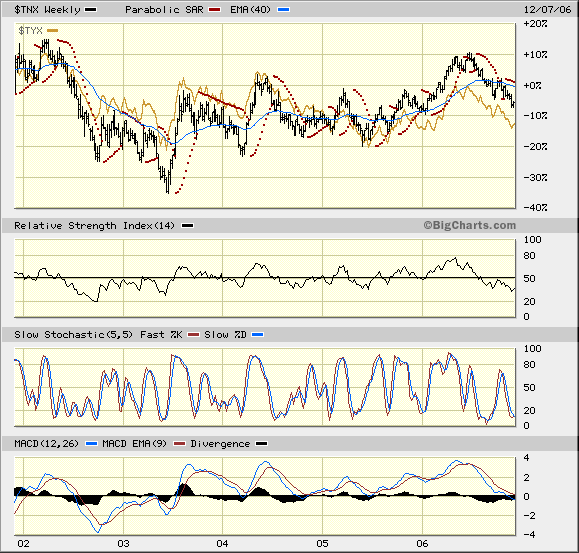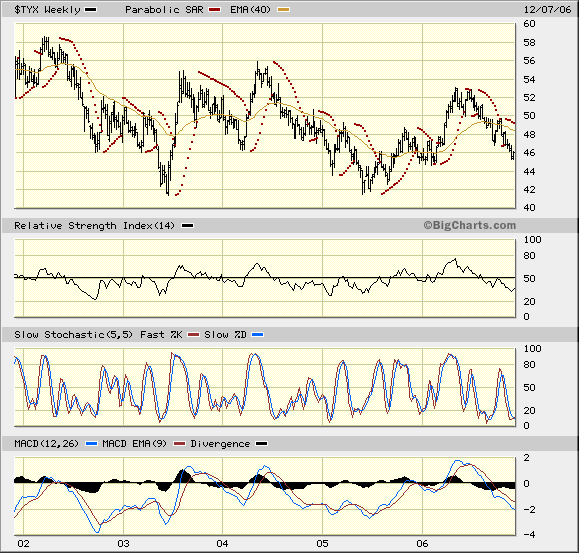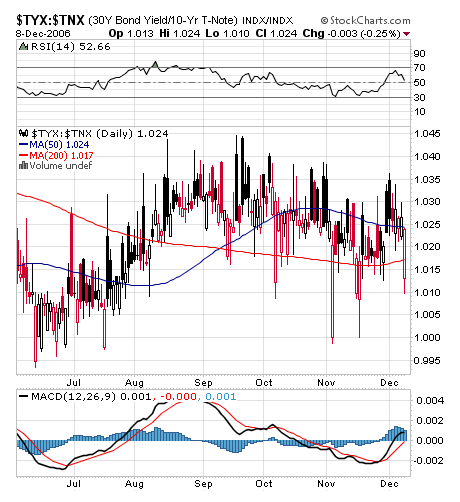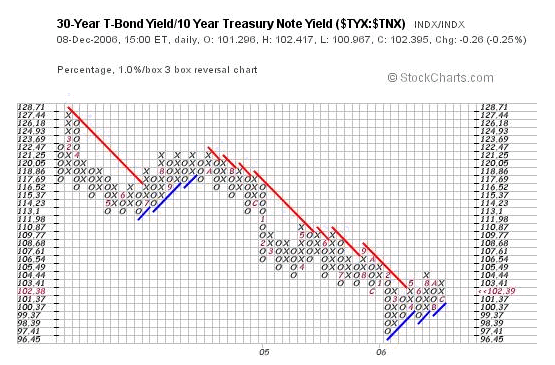Changes Afoot
Its amazing how one thing leads to another. For the past few months I have been writing a novel (nearing completion) and have not been following the markets particularly closely.
Last week the Relative Strength chart of the US Dollar/30 year yield caught my eye and I was drawn to investigate. My conclusion was that standards of living in the USA are likely to fall more steeply from this point even as the standards of living in India and China are likely to rise - and that this state of affairs seems likely to continue for some time until the two trends finally intersect some years down the track.
This week I thought I would test this reasoning - in particular, my tentative conclusion that the Central Bankers would be fighting to protect the integrity of the fiat currency system in general by supporting the US Dollar.
The chart below (source bigcharts.com) tells an interesting story, and one needs to bear in mind that the thirty year bond yield is the 'risk free benchmark' against which all other investment yields are notionally compared (which is precisely why the Fed wanted to do away with it, thereby maintaining its strategy of obfuscation).

The black bar chart is of the ten year yield and the orange line reflects the movement of the 30 year yield. The oscillators reflect the movements of the ten year yield.
Note how in early 2005 the 30 year yield fell below the ten year yield in relative terms. In strict economic theory, this was a sign that the market was expecting inflation to abate. Theoretically, when we are faced with inflation, money in 30 years time will be worth less than money in ten years time and so the longer dated yield should be higher - in order to compensate.
The attention of the reader is drawn to all three oscillators (The Relative Strength Index, the Slow Stochastic, and the Moving Average Cumulative Differential lines).ALL THREE are indicating that the ten year yield is likely to rise in absolute terms, although strictly speaking, the RSI is ambiguous.

Now, when we look at the blue MACD line in the chart above of the thirty year yield and we compare it to that of the blue MACD line of the 10 year yield, we see that the thirty year MACD is - relatively speaking - much weaker. Nevertheless, the slow stochastic is also giving a buy signal.
The questions that this raised in my mind were: "Could we be witnessing the beginning of a redress? Is the thirty year yield likely to rise faster than the ten year yield from this point?"
According to the chart below - of the $TYX:$TNX the answer appears to be "no" (Courtesy stockcharts.com)

But then I looked at the P&F chart below, and I started to think

The last time there was a series of three rising blue trendlines on this 1% X 3 box reversal chart it preceded a serious collapse, which took the ratio down from 1.2X to .96X (ie it resulted in an inverted yield curve) and this raised the spectre of deflation.
We are now facing a similar situation of a market "trying" to reverse that which had been in place for some time before.
If we have a similar outcome, and a serious fall from here in relative terms, then there can be no doubt that the forces of deflation will have won. If the ratio falls strongly below 1.0X there will be big trouble.
If, on the other hand, the ratio starts to rise from here on out, then this will indicate a market that expects the spectre of inflation to re-emerge.
Of course, it's impossible to make this particular call in advance, but it does seem that we might have reached a point of "final" decision in the debate that has been raging for some years now: "Will the fiscal insanity of the US Federal Reserve Board end in deflation or inflation or, perhaps something else? "
Clearly, a "best case" outcome will be a trading range - an essentially sideways movement that remains a sideways movement for years to come.
Unfortunately, from the perspective of a US citizen, this is a no win situation. Inflation from this point, where debt levels are high, will imply an increasing difficulty to make ends meet within relatively static incomes as the economy slows. If wages rise to compensate, inflation will accelerate and this will put intolerable pressure on the US Dollar. (That the economy is likely to slow flows from the slowing of velocity of money)
Deflation from this point - given the high debt levels - will mean that a dollar today is worth more than a dollar tomorrow. There will be pressure by lenders to protect their capital, and money will become very tight.
Unfortunately, sideways movement from this point will be like spending years in the dentist's chair - a seemingly interminable grinding on the nerve endings.
From the perspective of the World economy, inflation within the USA might well lead to hyperinflation and a US Dollar that becomes worthless. That will be seriously destabilising to the world economy. On the other hand, deflation will lead to wide scale insolvencies within the USA and an inability of the US Government to continue servicing its debts in any half-way honest fashion. This will also be unpalatable from the perspective of the ROW.
So, from the perspective of the World Economy, a "best case" scenario will be to let the US citizens continue writhing interminably in the dentist's chair whilst the rest of the world goes about its business. A best case scenario is a US Dollar which does nothing and Interest rates which stay where they are.
The solution from a US Citizen's perspective?
For those who can't cope: Happy Gas. Escapist behaviour.
For those who fight to remain sane: A turning away from 'materialism' and a return to 'family values'. Escalation of religion and spiritual growth.
For politicians: Irrational behaviour with a tendency to paranoia and a continuing propensity to degrade and minimise the rights of voters to express their honest views.
Unless something changes structurally.
Conclusion
If the US Dollar and interest rates trend sideways for years to come, people will come to understand that the "capitalist dream" was ephemeral. It seems that our economic, political and financial paradigms have reached their limits and are facing fracture.
It's time for structural change.
















